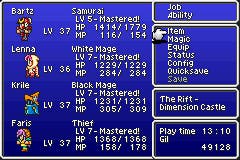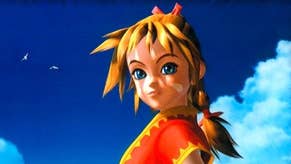Final Fantasy V Advance
14 years later...
In the days before Sony started making videogame consoles and Sega stopped, when Microsoft made Windows and Nintendo made millions, when games came on cartridges not discs and there were no such things as ROM files or emulators or IPS fan translation patches, and buses ran on time and children were seen and not heard and don't you know I fought in two world wars you ungrateful etc.
At that time, the only way this freshly pubescent correspondent could play and understand Final Fantasy V was to traipse over to a shady import shop in London, hand over £60, trawl whatever Internet search engine we used to have before Google and print out 400 pages of badly translated dialogue from a text-only website run by a Spanish man with terrifying dyslexia. Then painstakingly, I'd play the game using one of those foot high Super Famicom adapters on my SNES and try and keep track of the narrative on the A4 print out. Which was harder than you'd think what with the streams of kanji on screen seemingly condensed into the kind of wounded-pigeon English I'd probably speak if I were a pig farmer from Latvia who learned the language from the ingredients checklist on the back of a bootleg can of Coca-Cora. PS3 delayed until March? Boo-fricking-hoo. Seriously, you kids don't know you're even born these days.
So, for all these reasons, you're bloody well going to be grateful that today, fourteen years after it first launched, you have the opportunity to play Final Fantasy V on your GBA without the need of a sabbatical and government funding for the privilege. Of course, all of this could have been avoided if Square-Enix had bothered to release the game on the Super Nintendo in the West in the first place, but we'll forgive them that as they've clearly learned their lessons now what with being so prompt in bringing over Final Fantasy XII to us Eurogamers. Oh. Right.
Final Fantasy V is the lost SNES title in the series. Unless you bought the original Japanese cart and a handwritten translation, or tracked down the rare PSone release (with debilitating loading times) in Final Fantasy Anthology, then this is your first chance to play it legally. Released at a time when odd numbered Final Fantasy games emphasised the battle system and even numbered titles focussed on the story, you'll immediately notice the paucity of dialogue here.

The opening scenario is cute but sparse: You're Bartz, a wanderer who travels the world with his Chocobo, Boco, earning his living by... well, actually it never really gets that far. The earth's balance of elements is maintained, as was the case in all early Final Fantasy games, by four elemental crystals (and the less well known '70s pop band): Earth, Wind, Fire and Water. The wind crystal, that jewel which ensures ships sail, flags fly and kites soar, shatters at the game's opening. The Princess Lenna decides to investigate and, by accident, falls into Bartz's company. The unlikely pairing are swiftly joined by the amnesiac pensioner Galuf and a strong willed pirate girl, Faris.
The four then travel the world on the quest to save the crystals from whatever force is causing their combustion. It's an unlikely mixture of characters (although FF12 players will recognise some subtle echoes) but the team works well together. The translation, different from the one on FF Anthology, while a little staid and juvenile, does fairly well at communicating the camaraderie between the group. Indeed, it's surprising how, after a few hours, when a plot twist wrestles one from your grasp, you realise just how much affection you've invested in them.
However, where the game really shines is in the battling system and, more specifically, the job class mechanic. Final Fantasy V essentially wrote the rulebook on handling character class development and its influence can be seen today everywhere from Final Fantasy Tactics to Oblivion. After the first hour or so of gameplay it's possible to assign each of your characters a job class in which they specialise. Each class grants special abilities and gives the character a second levelling track to consider. You earn job class experience from battling as well as your usual character experience, jobs levelling up separately to characters. While your specialisation can be switched at any time, as you level up the job the special abilities it grants are learned and can be carried over into new job classes. So, for example, you might train Bartz to be a level 2 White Mage which will allow him to take the 'Cure' ability into a new job. So you switch his expertise to the Monk class which will enable him to hit twice in one attack while retaining the ability to heal others from his experience as a White Mage.

This system (a near carbon copy of which underpins Final Fantasy XI) made the game the first Japanese RPG to give players true control over their character's specialisations and abilities and its quality and elegance is clearly visible today. This is helped by a GBA conversion that features no load times and which has sped up the flow of battles so that they can be raced through with ease. The GBA conversion is also worth noting for the new features it brings to the title. A quick-save function (perfect for gaming on the go), updated graphics, four new jobs (Gladiator, Cannoneer, Necromancer, and Oracle), a reworked soundtrack and a new 30-floor bonus dungeon have also been incorporated into the package.
Of course, no matter how startling this game was in 1992, today it feels a little Fisher Price. But, that said, this is more than just a museum piece for today's JRPG fan. The speed of the gameplay is in stark contrast to today's lumbering epics, something that suits and shines on the GBA. Portable gaming and RPGs are hardly the most reasonable of marriages but you'll find that a surprisingly satisfying amount of progression can be made in your 30-minute commute. The game brilliantly balances the four essentials of successful RPG craft: a compelling story, quick-paced and deep fighting, compulsive team and item management, enjoyable side quests and secrets for the completist. So, while this probably won't be the last time Final fantasy V is released for a contemporary system, it may well be the best.









